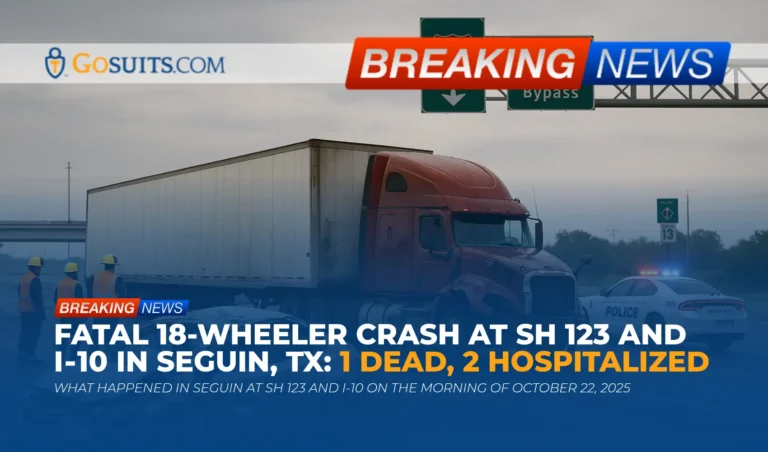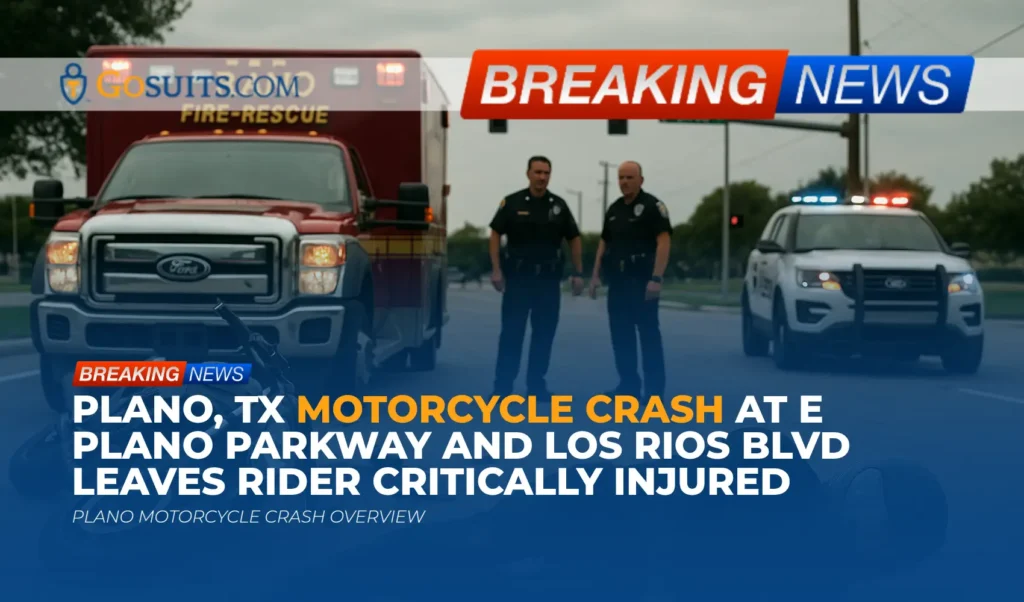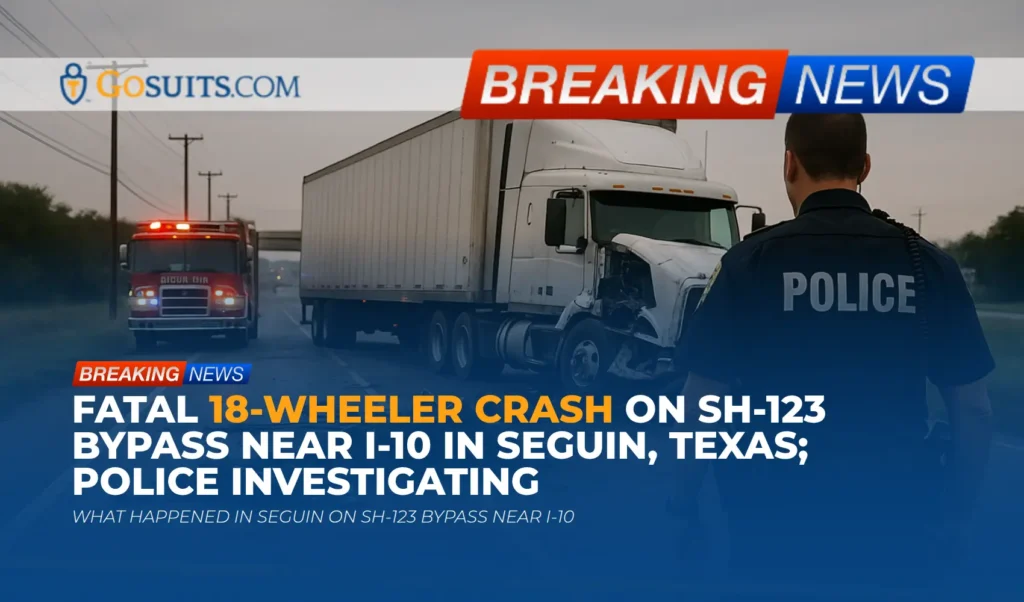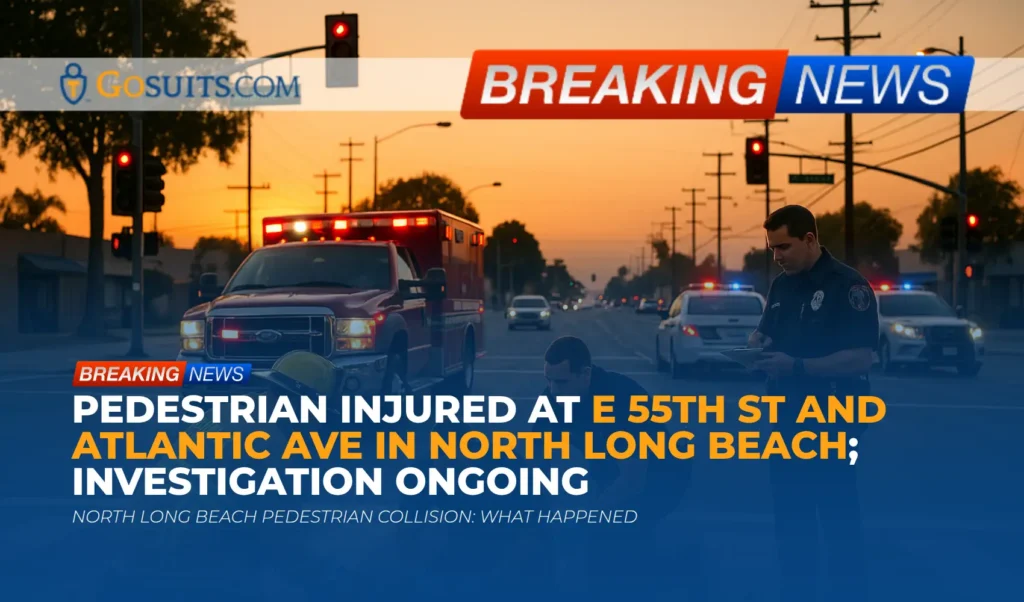- What Happened in Seguin at SH 123 and I-10 on the Morning of October 22, 2025
- Timeline, Location, and Initial Law Enforcement Statements
- Current Status of the Investigation and What It Typically Involves
- Where Families Can Get Official Information and Records
- Rights of Those Hurt and Families After a Fatal 18-Wheeler Crash in Texas
- Potential Liability in an 18-Wheeler Crash at a Highway Interchange
- Evidence That Often Determines Responsibility in a Truck Crash
- Insurance Considerations After a Serious Truck Collision
- Safety Context: Large-Truck Crashes in the United States
- Practical, Compassionate Steps to Consider in the Days Ahead
- Call-to-Action: Why Prompt Action Matters After a Major Truck Crash
- Commentary from Gosuits Seguin, Texas Personal Injury Attorney
What Happened in Seguin at SH 123 and I-10 on the Morning of October 22, 2025
Authorities in Seguin, Texas, responded early Wednesday to a devastating collision involving an 18-wheeler at the intersection of State Highway 123 Bypass and Interstate 10. According to information released to local media by a Seguin Police Department spokesperson, an 18-wheeler left the I-10 roadway and struck at least one passenger vehicle near the SH 123 Bypass interchange. One person was pronounced dead at the scene, and two others were transported to a hospital. As of the latest report, their conditions were not made public. The highway was closed in both directions during the investigation and emergency response.
Initial details indicate the crash occurred during the morning commute, when traffic in this corridor is typically heavy. The investigation is ongoing, and no further official determinations regarding cause or contributing factors have been announced.
Timeline, Location, and Initial Law Enforcement Statements
Time of the crash
Reports indicate the wreck occurred at approximately 6:30 a.m. during weekday rush-hour traffic.
Location
The crash took place along North SH 123 at the I-10 interchange in Seguin. This is a major regional junction connecting local traffic to a primary interstate corridor. The configuration of heavy trucks merging, exiting, and entering at interchanges can introduce complex traffic patterns and sudden speed changes, particularly in the early morning hours.
Law enforcement information released
Seguin Police confirmed that an 18-wheeler drove off I-10 and collided with at least one vehicle on or near SH 123. A department spokesperson stated that one individual died at the scene. Two additional individuals were transported for medical care. The police indicated that the incident remains under investigation and that more information will be released when available.
Current Status of the Investigation and What It Typically Involves
When a fatal collision involving a commercial motor vehicle occurs, multiple agencies and disciplines often become involved in the investigation. At a minimum, local police secure the scene, document evidence, and coordinate with fire and EMS. Depending on the facts, agencies may request accident reconstruction, vehicle inspections, and reviews of the truck driver’s compliance with federal and state safety rules.
Common investigative steps after a fatal truck crash
- Scene preservation and mapping — Measuring skid marks, yaw marks, gouges, debris fields, and resting positions of vehicles. These details help reconstruct speeds, braking, and impact dynamics.
- Event data recorder downloads — Passenger vehicles and commercial trucks often contain electronic control modules and other data recorders that capture pre-crash speed, brake application, throttle, and other parameters.
- Driver compliance review — Investigators may review hours-of-service compliance, vehicle inspections, and maintenance records. Federal rules limit driving hours and require specific rest breaks for most truck drivers, along with inspection and maintenance obligations for motor carriers. See the federal regulations at 49 C.F.R. § 395.3 and 49 C.F.R. Part 396.
- Drug and alcohol testing — After certain crashes, motor carriers must ensure post-accident testing of drivers in accordance with 49 C.F.R. Part 382.
- Witness statements and camera review — Statements from drivers and witnesses, along with traffic camera or private security video near interchanges, often help clarify the moments before impact.
Families and injured people rarely receive immediate answers. It’s normal for official findings to take time, especially where multiple vehicles are involved or where forensic analysis is required.
Where Families Can Get Official Information and Records
It is understandable to want clear answers as soon as possible. The list below outlines public points of contact and the types of documents that may be available in a case like this. Availability and timing depend on the stage of the investigation and Texas public-records rules.
Police crash report and records
- Seguin Police Department — The City of Seguin hosts information about city departments on its official website at seguintexas.gov. The Police Department’s Records Unit typically handles requests for local incident reports and can advise on how to obtain the Texas Peace Officer’s Crash Report (CR‑3) once it is finalized.
- State crash reports via TxDOT — The Texas Department of Transportation provides a process for obtaining crash reports statewide. For general guidance, visit txdot.gov and search for “Crash reports and records.” TxDOT’s CR‑3 crash reports are governed by state law and are available to certain parties and their representatives.
Autopsy, inquest, and death records
- Inquest/medical examiner process in Texas — Texas law provides that a justice of the peace or a medical examiner conducts inquests into certain deaths, including those from motor vehicle collisions. See Texas Code of Criminal Procedure, Chapter 49. Which office oversees an inquest depends on the county’s system.
- Death certificates — Certified death records are managed by the Texas Department of State Health Services. Eligibility and ordering information are available at DSHS Vital Records.
Hospital and emergency medical records
Individuals treated at a hospital, or their authorized representatives, may request medical records directly from the hospital’s Health Information Management (HIM) department. Hospitals have procedures for authorizations and next-of-kin requests in the event of a death.
Traffic operations and roadway information
TxDOT maintains information on roadway design, maintenance, and traffic operations for state highways and interstates. If roadway conditions, traffic control devices, or work zones are questioned, TxDOT’s district office information can be located through txdot.gov.
Rights of Those Hurt and Families After a Fatal 18-Wheeler Crash in Texas
Texas law allows certain family members to bring civil claims after a wrongful death, and it allows the deceased person’s estate to bring a claim for harms suffered between injury and death. These are different claims with different purposes. For reference to the statutes, see the Texas Civil Practice and Remedies Code, Chapter 71.

Wrongful death claim
A wrongful death claim may be brought by specific family members under Texas law. It seeks compensation for losses experienced by the family because of the death, such as loss of companionship and financial contributions. The statute is found in Chapter 71 of the Civil Practice and Remedies Code.
Survival claim
A survival claim is brought by the decedent’s estate to address harms the person suffered from the time of injury until death, such as conscious pain and mental anguish. This claim continues the decedent’s personal injury claim on behalf of the estate. See Section 71.021.
Time limits
Texas generally imposes a two‑year limitations period for wrongful death and personal injury claims, although specific facts can affect the clock. See Section 16.003 of the Civil Practice and Remedies Code for the general rule on limitations. Because deadlines can be unforgiving, prompt attention to the timeline is important.
Potential Liability in an 18-Wheeler Crash at a Highway Interchange
In a complex collision at an interchange, multiple parties may be investigated to determine civil responsibility. It is too early to assign fault in this Seguin incident without official findings, but generally the following parties can be examined in a commercial vehicle crash:
- Truck driver — Potential issues include fatigue, distraction, speed for conditions, or failure to maintain lane control. Compliance with hours-of-service and rest rules is often reviewed under 49 C.F.R. Part 395.
- Motor carrier (trucking company) — Carriers have duties regarding driver qualification, supervision, maintenance, and recordkeeping, including inspection and repair obligations in 49 C.F.R. Part 396.
- Maintenance providers — If an outside shop handled critical repairs or inspections, their work may be scrutinized for adherence to safety standards.
- Cargo loaders/shippers — Improper loading or securement can affect vehicle handling and stopping distance.
- Other motorists — Actions of any involved passenger vehicles may also be relevant to causation.
- Roadway conditions — In some crashes, the presence or absence of signage, lighting, or road surface conditions can be part of the analysis, which may involve TxDOT records.
Liability assessment relies on factual reconstruction, data downloads, and statutory and regulatory compliance analysis.
Evidence That Often Determines Responsibility in a Truck Crash
Commercial motor vehicle cases are evidence-intensive. Some materials are generated by the truck itself, while others come from the carrier, third parties, insurers, or public agencies. Several categories are especially important:
- Electronic logging device (ELD) and hours-of-service data — Carriers must retain driver duty-status records for at least six months. See 49 C.F.R. § 395.8. Supporting documents can include fuel receipts, bills of lading, and toll data.
- Inspection, repair, and maintenance records — Carriers must maintain records for each vehicle during its service period and for a period after it leaves service. See 49 C.F.R. § 396.3. Driver vehicle inspection reports (DVIRs) also have retention requirements. See 49 C.F.R. § 396.11.
- Telematics and event data — Many fleets use telematics systems that record hard braking, speed, and lane-departure events. Passenger vehicles often store crash data as well.
- Cargo documentation — Bills of lading, weight tickets, and load securement records can show whether cargo may have contributed to loss of control.
- Driver qualification and training files — Hiring, training, road test, and medical certification records may be reviewed in relation to regulatory standards.
- Scene and vehicle photographs — High-resolution images of undercarriage components, brakes, tires, and lighting can reveal mechanical issues or post-impact movement.
- External video — Intersection cameras, business surveillance, and dash cameras from uninvolved motorists can capture crucial angles that the involved drivers did not see.
Because certain records are kept for limited periods under federal rules, timely preservation requests are often important to ensure critical evidence is not overwritten or discarded in the ordinary course of business.
Insurance Considerations After a Serious Truck Collision
Commercial trucks are typically insured through a motor carrier policy, and there may be additional layers of coverage depending on the carrier’s size and contracts. Injured motorists and families should be mindful of how insurance communications are handled. What is said to an insurer, even in an early phone call, can be recorded and may affect later claims. Before any conversations with insurance adjusters, it is wise to consult with a qualified attorney to understand rights and obligations.
First-party coverages that may apply
- Personal Injury Protection (PIP) — In Texas, auto insurers must offer PIP coverage unless it is rejected in writing. See Texas Insurance Code § 1952.152. PIP can help with medical expenses and certain lost-income impacts, regardless of fault.
- Uninsured/Underinsured Motorist (UM/UIM) — Texas insurers must also offer UM/UIM coverage, which can be important if an at-fault party lacks sufficient coverage. See Texas Insurance Code § 1952.101.
- MedPay — Medical payments coverage is optional and can assist with medical bills up to purchased limits.
Third-party liability coverages
- Motor carrier liability — Policies covering the trucking company and driver may include higher limits than standard passenger policies, but claim handling can be aggressive and complex.
- Excess/umbrella policies — Some carriers maintain additional layers beyond the primary policy.
- Other potentially responsible parties — Depending on factual findings, maintenance contractors, loading entities, or other drivers may have separate insurers.
Practical guidance for insurance communications
- Consult an attorney first — Before providing recorded statements or signing any documents, speak with an attorney for a free consultation to understand the process and protect your rights.
- Be cautious with authorizations — Broad medical or employment authorizations can allow sweeping access to private records not related to the crash.
- Document everything — Keep logs of calls, correspondence, claim numbers, and adjuster names; save all mail.
Safety Context: Large-Truck Crashes in the United States
While each collision is unique, national data can help frame the public-safety stakes around truck crashes. The Federal Motor Carrier Safety Administration’s most recent comprehensive report indicates that in 2021, 5,700 large trucks were involved in fatal crashes in the United States, an 18 percent increase from 2020 and an increase from 2016 levels. See FMCSA’s Large Truck and Bus Crash Facts at fmcsa.dot.gov.
These figures reflect many different scenarios: highway speed collisions, underride situations, lane departures, work-zone crashes, and complex interchange events like major interstate junctions. Investigations typically look closely at speed, following distance, traffic density at merge points, and driver attentiveness during early morning hours when fatigue may be a concern.

Practical, Compassionate Steps to Consider in the Days Ahead
Serious crashes cause sudden upheaval. The following steps are offered in a spirit of care to help community members navigate the days and weeks after a tragedy. These are general suggestions and not tailored to any one person’s situation.
- Prioritize medical care and grief support — Follow through with all recommended medical evaluations. For those who have lost a loved one, consider speaking with a counselor, faith leader, or trusted support organization.
- Request key records — When available, request the Texas Peace Officer’s Crash Report (CR‑3) through the Seguin Police Department Records Unit or via TxDOT’s crash report process at txdot.gov.
- Death records and inquest information — Obtain certified death certificates through the Texas Department of State Health Services at dshs.texas.gov. If an inquest was conducted, the county justice of the peace or medical examiner can advise on public records related to the inquest. The inquest process is outlined in Texas Code of Criminal Procedure Chapter 49.
- Preserve evidence — Save all photographs, dashcam footage, vehicle data, medical records, and correspondence. If a vehicle is declared a total loss, request that it be preserved until a professional inspection can occur.
- Be cautious with insurance calls — Before speaking with any insurer or signing releases, consult an attorney. What you say can be used later to limit or deny claims. Early legal guidance can help you avoid common pitfalls.
- Track expenses and impacts — Keep receipts and a simple journal of medical appointments, time missed from work, and day-to-day impacts. This contemporaneous record can be important later.
- Mind the calendar — Texas law generally sets a two‑year time limit for personal injury and wrongful death claims, with exceptions in specific situations. See Civil Practice and Remedies Code § 16.003.
Call-to-Action: Why Prompt Action Matters After a Major Truck Crash
This section explains timely, concrete actions the public can take after a serious 18‑wheeler crash and why acting soon matters.
- Obtain official records as they become available — Request the police crash report and, if applicable, inquest documentation. These records anchor the timeline and are often required by insurers. Early requests help avoid delays that can stall benefits or claim evaluations.
- Secure and preserve vehicles and data — Ask storage yards and insurers to hold the involved vehicles so independent inspections can happen. Many electronic systems overwrite data within days or weeks; acting quickly can prevent permanent loss of crucial information.
- Collect and safeguard photos, videos, and witness information — Memories fade and camera systems loop. Download phone videos and photos, back them up, and identify potential witnesses while details are still fresh.
- Organize medical and employment records — Keep a folder with discharge summaries, imaging reports, time-off documentation, and billing statements. Organized records reduce frustration and speed up legitimate claims.
- Avoid premature statements to insurers — Initial conversations can shape how claims are viewed. Speak with a legal professional first to understand what information is necessary and how to protect your interests.
- Schedule a free legal consultation — A no‑cost consultation provides an overview of options, typical timelines, and how evidence is preserved. This can reduce uncertainty and help with informed decision‑making.
Urgency matters because important evidence can disappear quickly, deadlines can approach without warning, and early missteps in statements or paperwork can have long-term consequences. Taking organized, thoughtful steps now helps lay the groundwork for clarity and accountability later.
Commentary from Gosuits Seguin, Texas Personal Injury Attorney
Our hearts are with everyone affected by the collision at SH 123 and I‑10. One life lost and multiple injuries in our community is a heavy burden. This overview is offered for educational purposes and general information. We extend our sympathy to the families and individuals navigating shock, grief, and uncertainty right now.
From a civil injury perspective, a crash in which an 18‑wheeler leaves the interstate and strikes a passenger vehicle at an interchange raises immediate questions about speed for conditions, driver attentiveness, roadway geometry, and potential mechanical issues. It is also important to evaluate whether federal safety rules were followed in the days and hours leading up to the crash, including hours‑of‑service limits, proper inspections, and post‑accident testing requirements under 49 C.F.R. Part 382. These cases often hinge on time-sensitive evidence unique to commercial motor carriers, such as ELD data, telematics, and maintenance records.
Insurance companies and large corporations manage these events with experienced adjusters and rapid-response teams. They routinely gather statements early, request broad medical authorizations, and frame disputes in ways that may minimize their financial exposure. People who are hurt, or families dealing with a loss, are at a disadvantage in those first days because they are focused on medical care and grieving. Knowing your rights before speaking with insurers can prevent avoidable misunderstandings and protect you from inadvertently giving up important protections.
A free consultation with a seasoned attorney can help you understand the process without any obligation. It is an opportunity to ask questions about evidence preservation, insurance coverages that may apply, realistic timelines, and the role of state and federal regulations. Even a short conversation can reduce uncertainty and help avoid steps that might later limit your options.
For official updates, keep an eye on the City of Seguin’s website at seguintexas.gov and TxDOT’s resources at txdot.gov. For death certificates and information about inquests, see the Texas Department of State Health Services at dshs.texas.gov and the Texas Code of Criminal Procedure, Chapter 49, at statutes.capitol.texas.gov.






